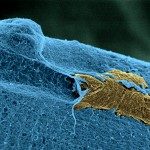Lien vers Pubmed [PMID] – 8151749
J. Virol. 1994 May;68(5):2781-6
Theiler’s virus is a neurotropic murine picornavirus which, depending on the strain, causes either an acute encephalitis or a persistent demyelinating disease. Following intracranial inoculation, the demyelinating strains infect sequentially the grey matter of the brain, the grey matter of the spinal cord, and finally the white matter of the spinal cord, where they persist and cause chronic demyelination. The neurovirulent strains cause a generally fatal encephalitis with lytic infection of neurons. The study of chimeric Theiler’s viruses, obtained by recombining the genomes of demyelinating and neurovirulent strains, has shown that the viral capsid contains determinants for persistence and demyelination. In this article we describe the recombinant virus R5, in which the capsid protein VP1 and a small portion of protein 2A come from the neurovirulent GDVII strain and the rest of the genome comes from the persistent DA strain. The capsid of virus R5 also contains one mutation at amino acid 34 of VP3 (Asn–>His). Virus R5 does not persist in the central nervous system (CNS) of immunocompetent SJL/J or BALB/c mice. However, it replicates efficiently and persists in the CNS of BALB/c nu/nu mice, showing that its growth in the CNS is not impaired. In BALB/c nu/nu mice, whereas virus DA causes mortality with large amounts of viral antigens in the white matter of the spinal cord, virus R5 does not kill the animals, persists in the neurons of the grey matter of the brain, and never reaches the white matter of the spinal cord. This phenotype is due to the chimerism of the capsid and/or to the mutation in VP3. These results indicate that the capsid plays an important role in the characteristic migration of Theiler’s virus within the CNS.

